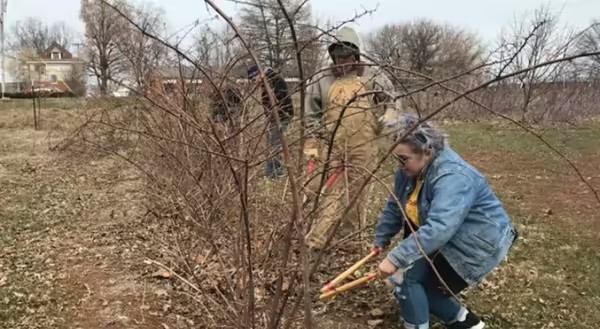
One of the simple joys of summer is picking berries straight from the bush and enjoying a sweet treat. Pruning blackberry and raspberry bushes now ensures a bumper harvest in the summer.
“As a child, my grandparents would send my sisters and I to the unmanaged portions of their property to pick just enough blackberries from the gangly, thorny bushes for a pie,” says Kelly Allsup, University of Illinois Extension horticulture educator. “Although, this was a tactic to get us out of the house, if those wild berries had been pruned in late winter, we might have brought back enough for 10 pies.”
Pruning backyard brambles in February or March when the plants are still dormant forces them to branch out when they start to grow, which creates more wood on which fruit can grow.
Bushes have different pruning needs depending on their attributes. Everbearing plants need to be trimmed in late winter; erect brambles need pruning in summer, as well. To make pruning less intimidating, Allsup recommends identifying the cultivar to make a plant-specific plan before bringing out the loppers.
Primocanes and Floricanes
Blackberry and raspberry bush canes, the bramble’s stems, are a mix of primocanes and floricanes. Primocanes are vibrant green, new growth canes. These canes are not ready to produce flowers or fruit, except for fall-bearing brambles.
Floricanes are older, overwintered canes that produce flowers and fruit and can be productive for up to 20 years. These dark red stems are covered in a white bloom, which rubs off and is used by the plant as a sunscreen.
“Without pruning or cutting back canes, the bush produces less fruit and can harbor disease and pests,” Allsup says. “Old fruiting structures on the plant indicate that the cane is a floricane that should be removed.”
For example, on a semi-erect blackberry ‘Chester Thornless,’ remove floricanes and diseased canes until there are only six to eight of the strongest primocanes left. On these branches, cut back the tip of the stem to 5 feet. The primocanes will have lateral branches that should be pruned to 18 to 24 inches long. If pruning a thorned variety, wear gloves and long sleeves.
Everbearing and Biennial Canes: Most brambles produce on biennial canes, but some are everbearing, which means they can bear fruit until the fall. If the primocanes that bore fruit in the fall are left to overwinter, they will fruit again, lower on the cane, in late spring and then die. By mowing down all the canes in late winter, there will be a more abundant fall harvest.
Erect and Semi-erect: Erect brambles, common in both raspberries and blackberries, produce stiff, upright canes that need summer and winter pruning. They tend not to need a trellising system. Semi-erect brambles produce thick, arching canes that benefit from winter pruning. If not supported by trellises, these varieties will bend over to trail along the ground and begin to root, limiting fruit production.
Root Suckers and Hills: Root-suckering brambles create a hedgerow and spread by root suckers. They are thinned by cutting canes to the ground, leaving 6 inches between canes and removing any canes outside of the row. Some brambles retain their individual plant form in a “hill.” To prune, remove last year’s floricanes and tip back the primocanes.
Pruning at Spring Planting
New plants should also be pruned to the ground when they are planted in early spring. If you’re looking for cultivar recommendations for Illinois, visit Small Fruit Crops for the Backyard.
Most plants purchased online will come bare-rooted and should be soaked in water for at least 30 minutes before planting. Plants from nurseries or greenhouses may come potted up and will not require soaking.
Plant new brambles 4 to 6 feet apart in a hedgerow when the soil is not wet. Hedgerows should be 10 to 12 feet apart for Illinois semi-erect varieties.
Dig a hole one and a half times wider than the root system and fan out the roots. Water immediately and at least every two to three weeks after planting. After planting, apply shredded bark mulch, up to 3 inches thick, away from the base of the plant. Apply fertilizer a month after planting.